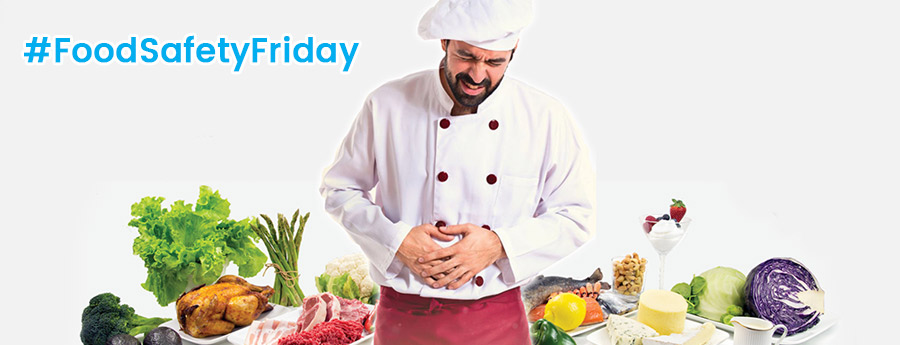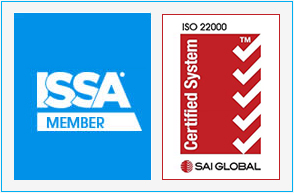Food Safety Friday Tips
Week 18
For cleaning equipment in food processing facilities we recommend that:
1. A well planned colour coding program is implemented in your facility;

2. The program adequately distinguishes between:
• High/Low risk areas
• Food contact vs Non-food contact
• Product Handling vs Non product handling
• Dirty/Clean areas
• Halaal
• Allergens
• Glass breakage;
3. The correct type of cleaning equipment is used for every task;
4. Approved shadow boards are used as part of the colour coding program to enhance food safety;
5. Equipment be cleaned and sanitized as part of the cleaning and sanitation program and using clearly defined procedures;
6. Equipment be stored appropriately i.e. brushes and brooms facing head down to avoid cross-contamination of the handle;
7. Equipment is checked regularly for any damage that might pose a foreign matter risk;
8. Reconciliations are done to ensure no equipment is missing;
9. Only approved cleaning equipment is used – look out for the following icons:

![]()
![]()
![]()
10. Your supplier be able to provide the necessary compliance documentation for ALL products.
Week 17
For drains in processing facilities we recommend that:
1. Drains are designed in such a way that they function properly and flow in the appropriate directions;
2. Restroom drains should not be connected to drains serving food processing areas;
3. Prevent accumulation of standing water around drains by ensuring that drains flow freely;
4. As far as possible do not install stationary equipment used for food processing directly above drains;
5. Ensure that drains are accessible for adequate cleaning;
6. Use appropriate, dedicated tools to clean drains and ensure that these are easily identifiable and are not used to clean any other equipment (e.g. colour coding);
7. When cleaning and sanitizing, the correct sequence should be followed;
8. Set up a drain cleaning schedule;
9. Drains and floors be cleaned and sanitized daily;
Week 16
Hygienic Entrances: Foamers, Footbaths & Dry Powdered Sanitizers, Minimize the risk of pathogen transfer from non-food/product handling to food/product handling areas by considering the use of Foamers, Footbaths or Dry Powdered Sanitizers where personnel enter food processing areas.
1. Footbaths – Are more appropriate in wet processing environments. Usually a water tight alcove/recess in the floor or a low flat container which is filled with a suitable sanitizer and has a non-slip surface. When footbaths are non-automatic, they should be checked regularly to ensure that they remain filled and that the sanitizer dilutions are correct.
2. Foamers – Suitable for wet processing environments. A foam disinfectant is automatically sprayed on the floor where personnel enter the processing areas or where trolleys or cart enter. Foamers should be maintained to ensure the correct amount of disinfectant is delivered.
3. Dry powdered sanitizers: Generally more suitable for dry processing facilities to keep the environment dry.
4. Foamers, footbaths and dry powdered sanitizers should be strategically placed to ensure that personnel cannot avoid them when entering food/product handling areas.
Week 15
Clothing & Footwear: Depending on the production environment, consider the following practices in terms of clothing.
1. Clothing and footwear should be checked regularly to ensure that they are in good condition;
2. Personnel should wear approved clothing which suitable for the production environment such as smocks, overalls, conti-suits, uniforms etc.;
3. PPE (personal protective equipment) for employees working in food/product handling areas should not be worn in non-product handling areas;
4. Distinguish clothing worn in food/product-handling & non-food/product handling areas by means of colour coding; and
5. Smocks/Uniforms/Conti-suits should be laundered or disposed of daily
Week 14
Gloves: When gloves are used in a food processing environment the following recommendations should be considered:
1. Gloves should be in free of any tears and either easily cleanable or disposable;
2. Wash hands thoroughly before putting on gloves;
3. After individual touches of non-food contact surfaces single use gloves should be discarded and replaced;
4. Wash and sanitize multi-use gloves before personnel use and after touching and non-food contact surfaces such as control panels, tools, doorknobs etc.;
5. Gloves worn outside areas where food is processed should be discarded before entering food handling areas; and
6. Gloves should be made of materials approved for use in a food processing environment.
Week 13
The suggested minimum internal temperature when cooking raw lamb, beef, veal and pork roasts, chops or steaks is 62.8 ºC as measured with a food thermometer. Allowing meat to rest for at least 3 minutes before consuming improves the safety and For safety and quality. If preferred, consumers may choose to cook meat to higher internal temperatures. Poultry should at least be cooked to an internal temperature of 73.3 ºC.
Week 12
Whenever there’s a food recall, check products stored at home to make sure they are safe.
Week 11
Store raw meat, poultry and seafood tightly wrapped on the bottom shelf of the refrigerator. This prevents the raw juices from dripping on other food.
Week 10
Discard cans that are dented, rusted, or swollen. High-acid canned food (tomatoes, fruits) will keep their best quality for 12 to 18 months; low-acid canned food (meats, vegetables) for 2 to 5 years. (Refer to dates provided on actual products).
Week 9
Know your temperatures & storage times: Cold storage chart
Week 8
To maintain quality when freezing meat and poultry in its original package, wrap the package again with foil or plastic wrap that is recommended for the freezer.
Week 7
Purchase refrigerated or frozen items after selecting your non-perishables.
Week 6
Prevent Cross Contamination: Keep raw meat, poultry, fish, and their juices away from other food. After cutting raw meats, wash hands, cutting board, knife, and counter tops with hot, soapy water. It is recommended to prepare low-risk foods before high-risk foods.
Week 5
Moulds on Food: Know when it is safe with this easy to use guide.
Week 4
The Danger zone
Leaving food out too long at room temperature can cause bacteria (such as Staphylococcus aureus, Salmonella Enteritidis, Escherichia coli O157:H7, and Campylobacter) to grow to dangerous levels that can cause illness. Bacteria grow most rapidly in the range of temperatures between 5°C and 60°C, doubling in number in as little as 20 minutes. This range of temperatures is often called the “Danger Zone.”

Week 3
Remember: If you are using material shopping bags for your groceries, wash them often as they can harbour bacteria that can contaminate other foods and cause foodborne illnesses.
Week 2
Thawing: The refrigerator allows slow, safe thawing. Make sure thawing meat and poultry juices do not drip onto other food.
Week 1
Do not leave perishable foods out for more than 2 hours at room temperature or more than 1 hour when the temperature is above 32.2 ºC (90 °F).
Comments are closed.





